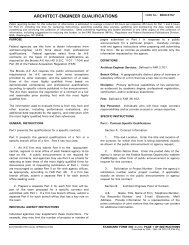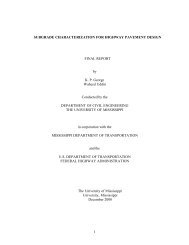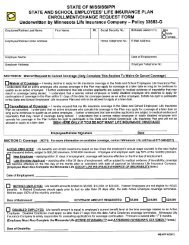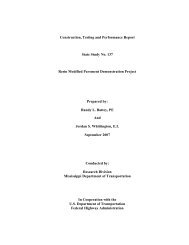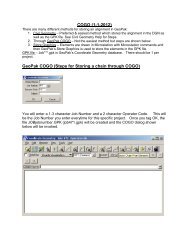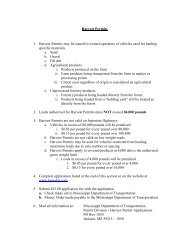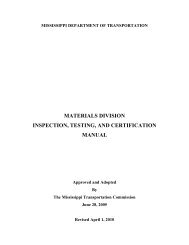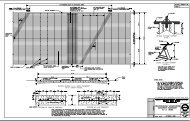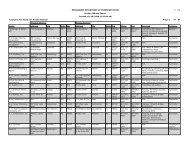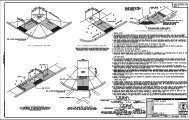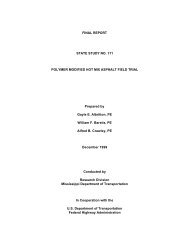Annual Report 2010.pdf - Mississippi Department of Transportation
Annual Report 2010.pdf - Mississippi Department of Transportation
Annual Report 2010.pdf - Mississippi Department of Transportation
Create successful ePaper yourself
Turn your PDF publications into a flip-book with our unique Google optimized e-Paper software.
Cooling Construction<br />
The typical pavement material you see steaming as it is rolled<br />
onto the highway is known as Hot Mix Asphalt. In FY 2010, MDOT<br />
included specifications in all contracts to allow contractors to<br />
use “Warm Mix” instead. This type <strong>of</strong> asphalt is about 50 degrees<br />
cooler than Hot Mix, which helps reduce the environmental<br />
impacts <strong>of</strong> construction activities. Further, less fuel is needed to<br />
heat the mix to the proper temperature, resulting in environmental<br />
and cost savings.<br />
Recycling Pavement<br />
Did you know pavement can be recycled? When a highway is<br />
worn out and in need <strong>of</strong> repaving or reconstruction, the old asphalt<br />
can be ground up and used as aggregate in the new pavement<br />
mix. This provides substantial environmental benefits—<br />
less construction waste ends up in landfills, less new material is<br />
needed, and less truck traffic is generated during construction. In<br />
FY 2010, MDOT began a Full Depth Reclamation Project—reusing<br />
nine inches <strong>of</strong> old asphalt pavement—during the reconstruction<br />
<strong>of</strong> U.S. Highway 49 in Madison County.<br />
Reusing Road Signs<br />
DOTs are responsible for thousands <strong>of</strong> road signs. In the past,<br />
when old signs were retired, they were sold as scrap aluminum.<br />
Recycling is good, but reusing is better. In FY 2010 the Traffic<br />
Engineering Division began working with a company that strips<br />
<strong>of</strong>f the old reflective sheeting (the colored front <strong>of</strong> the sign) using<br />
a specially designed “hydro-stripper.” They then apply new<br />
reflective sheeting according to MDOT specifications, and the<br />
sign is ready to be installed. This method is more environmentally<br />
responsible and also cheaper than buying new sign panels.<br />
Reclaimed signs were recently installed at a U.S. Highway 45<br />
interchange in Baldwyn, north <strong>of</strong> Tupelo.<br />
Improving Continuously<br />
MDOT’s commitment to environmental responsibility was further<br />
formalized in FY 2010 through the launch <strong>of</strong> the Environmental<br />
Stewardship and Compliance Program. The program is aimed<br />
at ensuring that MDOT’s policies and procedures demonstrate<br />
complete compliance with federal environmental standards and<br />
that MDOT is continuously improving environmental results. A<br />
first step was conducting field inspections to evaluate the effectiveness<br />
<strong>of</strong> erosion control practices at active construction sites.<br />
49




